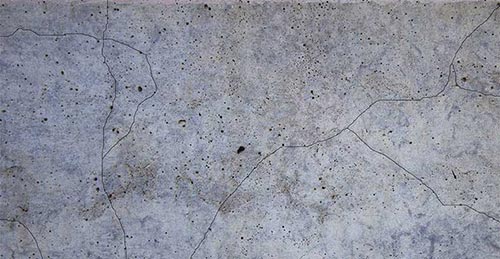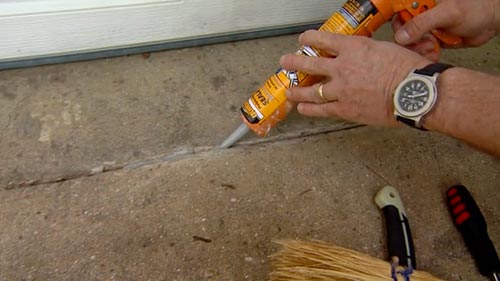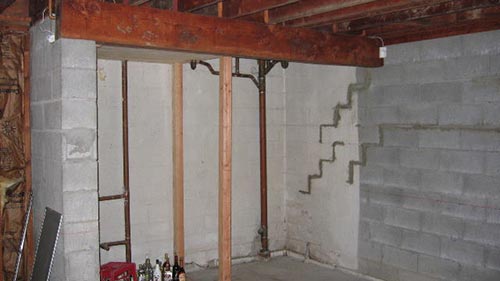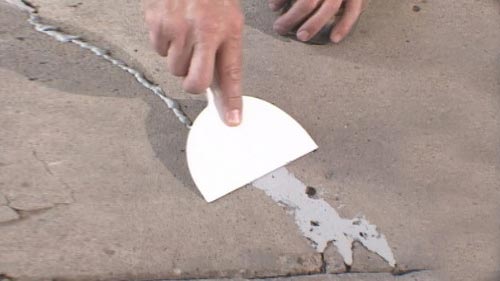In previous issue, Article 1: Finding and Monitoring Foundation Cracks, the early signs of foundation problems were discussed. Some basic inspection methods were also discussed that would help home owners to identify potential problem areas. Knowing some basic information about the type and location of cracks in the foundation can help homeowners determine if there is a serious problem and when they should call in a specialist.
In this article, the different types of cracks, as well as the likely cause and repair method, will be discussed.
Cracks in the basement walls can indicate a potential problem with the foundation of a home. The masonry material and concrete that are used in the construction of foundation walls are strong in compression but not as strong in tension. Therefore, any kind of movement or force that creates tension stresses in the foundation walls can cause cracks.
Foundation walls cracks (on basement walls) can be divided into six general categories:
Hairline Cracks
Cracks at L-Shaped Sections
Stair-Step Cracks
Settlement Cracks
Vertical Cracks
Horizontal Cracks
1 – Hairline Cracks
This type of crack usually occurs in the basement on the mortar joints between concrete blocks, on concrete walls and floors, and also on drywall with either steel or wood studs. The cause of these cracks is usually the movement caused by the expansion and contraction of the construction materials. This type of crack is common as this slight movement is normal and is not related to the quality of the construction of the building.
These cracks are not usually a concern and are easy to repair. In order to repair hairline cracks on drywall, speckling paste or drywall mud that is available at any home hardware store can be used. Repairing cracks on mortar joints and concrete surfaces is slightly different and will be discussed further below.
2 – Cracks at L-Shaped Sections
This type of crack forms where the foundation wall meets the grade level. The most likely cause of this type of crack is concrete shrinkage. The telltale sign is that the crack follows an irregular path and narrows to a hairline crack.
Concrete is comprised of water, cement and aggregate. As the concrete cures, it will shrink and the curing process is highly sensitive to temperature. For example, a freezing cold night at the time the foundation concrete is poured will make the concrete cure too slowly and conversely, a hot and humid sunny day will make the concrete cure too quickly. If the curing process is interrupted by a sudden change in temperature cracks are likely to form.
These cracks are not usually a sign of problems in the basement and foundation walls. However, it’s highly recommended that these cracks be repaired in order to prevent moisture and bugs from getting into the house. In order to repair and seal the crack, first remove any excess cement or mortar by lightly chipping it away using a screwdriver. Second, clean the crack with a vacuum or brush. Then fill the crack with concrete repair caulk, smoothing for a uniform finish.
3 – Stair-Step Cracks
The main reason for the formation of the stair-step cracks is uneven settlement of the house footing. Most stair-step cracks are caused by the normal settlement of a building over time. However, uneven settlement can be the result of something like moisture behind the foundation walls. For example, a plugged gutter could cause water to be directed to the area around the foundation walls rather than away from the house and that water will exert hydrostatic pressure on the foundation walls.
Stair-step cracks have diagonal zig zag pattern which follows the mortar joints between foundation concrete blocks. If moisture behind the foundation walls is the cause, the crack path usually follows the line where the moisture is present. If the crack is wider than ¼ inch or the basement wall is bulging, immediate attention is required.
Before attempting to repair these cracks, the propagation (spread) of the cracks needs to be stopped. In order to confirm that the crack is active, monitoring the crack is suggested. Stair-step cracks due to normal settlement will usually reach a steady state (no further propagation) within a short period of time; monitoring the cracks for 2 to 4 months should ensure the cracks are no longer active. Since these cracks do not pose a serious risk to the structural stability of the house, there is time available to perform the monitoring.
In order to monitor a crack, mark both ends of the crack with pen and measure the width. This information and the time and date of the marking and measurement needs to be recorded. Repeat the process every month for 2 to 4 months. This record will help to identify the progress of the crack if it is active or if it is at a steady state.
Another method of monitoring the width of a stair-step crack is to stick a piece of tape across the crack. Cut the tape with a razorblade at the crack location. Check to see if the thin cut gets wider throughout the monitoring period. Crack monitoring devices are also available in stores.
If the crack doesn’t appear to reach a steady state or any lateral movement is noted, it’s highly recommended to contact a specialist immediately. A specialist can determine the cause of the crack. Lateral movement is characterized by a bulging of the wall as shown below.
If it is determined that the crack does not represent a serious problem and it is at a steady state, it can be repaired easily. Remove any loose mortar around the crack and sweep away all dust and debris. Fill the gap with premixed mortar which is available at any home hardware store. Narrower cracks can be widened slightly to make it easier to fill by chipping away some of the surrounding mortar. Following the repair on the interior wall, the exterior wall should be repaired as well; this type of crack usually occurs in mirror on the exterior foundation face.
Since the crack will likely be below the ground elevation, not much repair can be done on the outside wall without digging down beside the wall to expose the crack. This can be a considerable and costly task.
To prevent water from accumulating around the foundation walls and worsening the situation, here are a few things that can be done: ensure the landscaping around the house is sloped away from the foundation walls so that the rain and snow-melt do not drain towards the walls, ensure gutters are cleaned often and make sure downspouts are directed away from the house
Parts 2 of this series will discuss the remaining types of cracks: Settlement Cracks, Vertical Cracks and Horizontal Cracks. Additional details are available upon request.
Please contact us at 647-343-0915 or by email at info@tegstructures.ca or r.razmi@tegstructures.ca.



